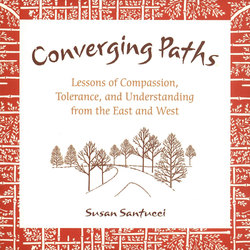Читать книгу Converging Paths - Susan Santucci - Страница 8
На сайте Литреса книга снята с продажи.
ОглавлениеIntroduction
We have to allow what is good, beautiful,
and meaningful in the other's tradition to transform us.
—Thich Nhat Hanh
Over the past decade, thousands of Americans have been creating highly personal forms of worship, drawing ideas from different faiths and teachers. Studies show that baby boomers and Generation Xers are five times more likely than their parents to search outside the religion of their childhood for spiritual answers. They want a religion that speaks directly to their personal lives, keeps pace with the changes in modern society, and gives a personal experience of the divine. Many are nourished by more than one spiritual root, have more than one guide, or even belong to two distinct religions. Americans have been turning in record numbers to the East to nourish their spiritual lives. Buddhism is now one of the fastest-growing faiths in America.
The East has a great deal to offer. But what is it? The East has developed, over 3,500 years, some of the best methods for attaining God awareness found anywhere in the world. The East also offers centuries of wisdom on the art of happiness and concrete ways to deal with stress and anxiety.
You may be surprised to find out how smoothly Eastern practice can complement, and even strengthen, your own spirituality or religious faith. Eastern faiths let us see our own religion with new eyes. My own spiritual search is an example. I was raised a Christian, but I never truly embraced the teachings of Jesus until I found Buddhist and Swami teachers who embodied Christ's love and compassion. Take, for example, the Eastern view of suffering. We all know the Western approach to suffering is influenced by the commercial culture we live in. Take an aspirin. Buy a sports car. Buy off your pain. But Buddhism teaches that life is inseparable from suffering. Devout Buddhists ask, "How can we embrace suffering?" Western thought is adept at making apt distinctions between things. It's no surprise that many Western thinkers have defined such things as God, heaven, and divinity as things apart from us. But Eastern mystics see no separation between the worldly and the divine. This view may take some getting used to. But it offers an amazing vision for westerners who seek a direct experience of the sacred.
Although there are differences in emphasis, at their core, the teachings of great saints are very similar. The original teachings of Jesus and Buddha share themes of kindness, compassion, love, tolerance, and passion for individual awakening. They took different routes to the same destination. People who have God awareness don't quibble over the narrow differences between traditions. They recognize one another as brothers. As Gandhi said, "God has no religion."
Balancing values from both traditions may be the greatest key to happiness and fulfillment. Buddhist Zen master Thich Nhat Hanh said, "To me religious life is life. I do not see any reason to spend one's whole life tasting just one kind of fruit. We can be nourished by the best values from many traditions."
Converging Paths is an inspirational collection of parallel sayings from great Eastern and Western teachers. From Jesus and Buddha to Mother Teresa and the Dalai Lama, these words can inspire, inform, and nourish your spirit. Each page offers a pair of dynamic quotes, followed by a practical piece of advice, written to offer comfort, guidance, hope, and encouragement.
This little book is thought provoking but fun. It will challenge you to expand your outlook. Whatever your faith, these timeless thoughts can recharge your being. Lose yourself in these pages—they will offer your spirit the greatest wisdom of the ages. Even a few moments of practice, done fully, can alter the rest of your day.
—Susan Santucci
Cambridge, Massachusetts
